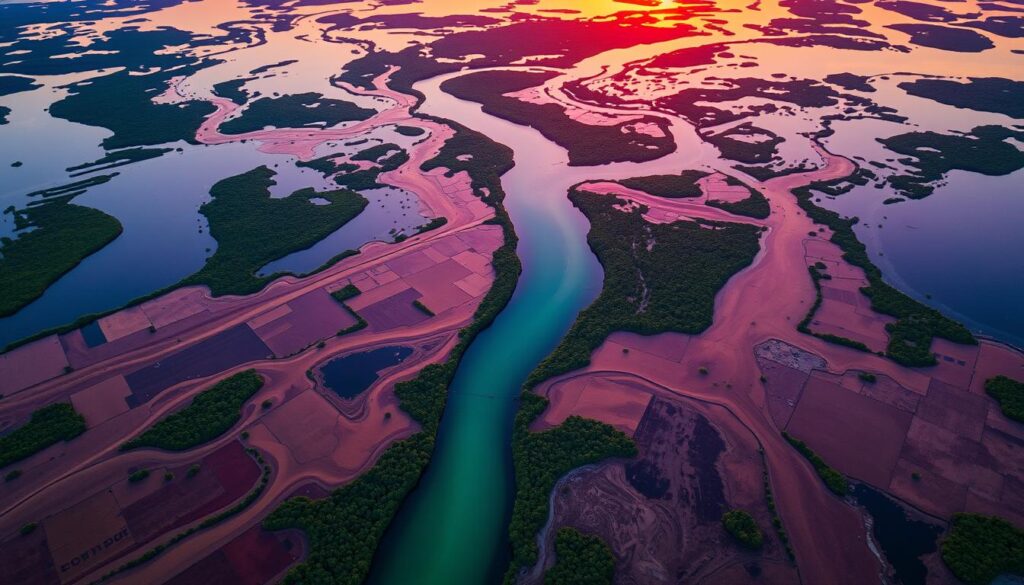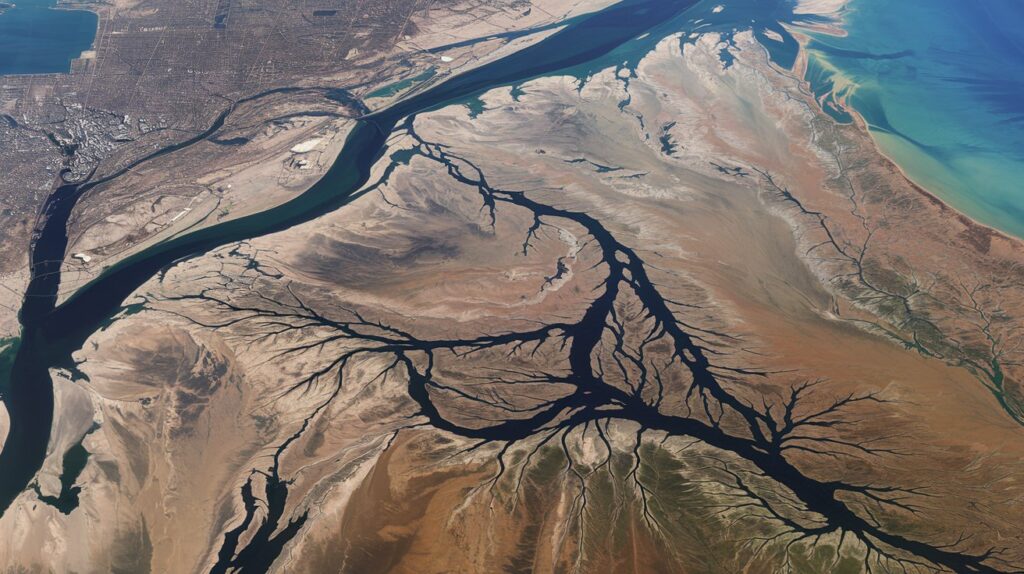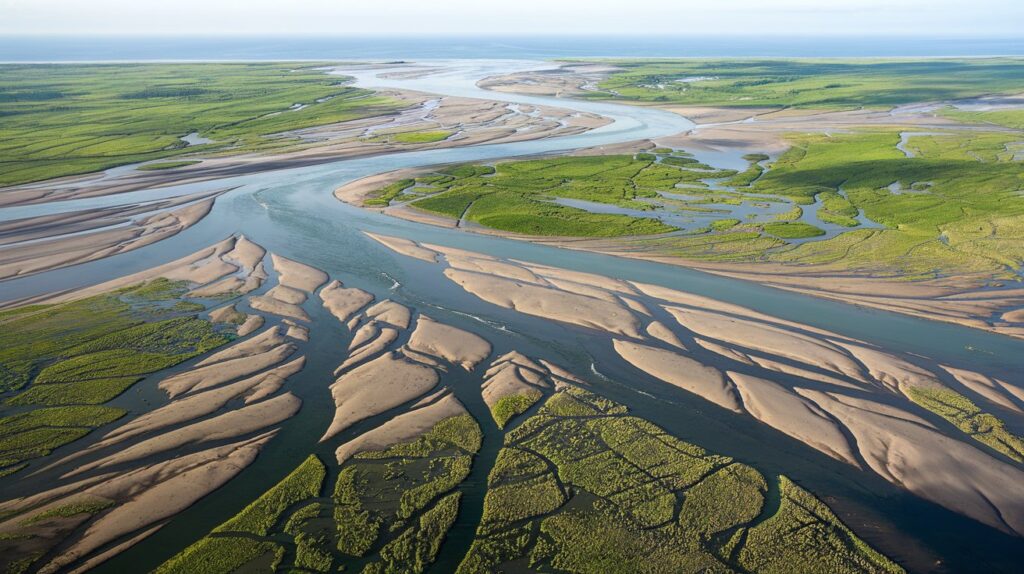
Aerial view of a vibrant river delta at sunset, showcasing intricate waterways branching out and lush green vegetation, with sediment deposits creating a mosaic of colors, surrounded by tranquil water bodies reflecting the sky’s hues.
Deltas are amazing landforms found where rivers meet oceans, seas, or lakes. They are low, flat, and often look like triangles or fans. The way deltas form is quite interesting, thanks to the river’s sediments.
When a river meets calm water, it slows down. This lets the sediments settle, building up the delta over time. This process gives deltas their unique shapes. Not only are they beautiful, but they also support life and communities.

Key Takeaways
- Deltas are low, nearly flat, alluvial land forms deposited at or near the mouth of a river where it enters a body of standing water.
- They are triangular or fan-shaped plains that extend beyond the general trend of a coastline.
- Deltas are formed from the deposition of the sediment carried by the river as it slows down upon entering a larger body of water.
- Deltas play a vital role in supporting diverse ecosystems and providing resources for nearby communities.
- Understanding the formation and characteristics of deltas is crucial for coastal management and environmental conservation efforts.
Unveiling the Secrets of Delta Formation
The formation of deltas is a complex and fascinating process. It involves the interplay of several key factors. At the heart of this process lies the power of sediment deposition. The river carries and deposits sediment at its mouth, gradually building up the delta over time.
The Power of Sediment Deposition
As a river flows towards the sea, it carries an abundance of sediment. This includes fine particles of soil, sand, and silt eroded and transported from upstream. When the river reaches its mouth and encounters a body of standing water, such as an ocean or a lake, the river’s flow slows down.
The sediment it carries begins to settle out, forming a delta formation process. Over time, this alluvial deposition builds up the delta. It creates a low, nearly flat, triangular or fan-shaped plain that extends beyond the general trend of the coastline. The rate at which the delta grows is largely determined by the amount of sediment the river carries and the balance between the river’s flow and the influence of tides.

The Role of River Flow and Tides
The river flow plays a crucial role in shaping the delta. It carries the sediment and deposits it at the river’s mouth. The strength and direction of the river flow can influence the shape and structure of the delta.
Faster-flowing rivers typically create more elongated deltas. Slower-flowing rivers form more rounded, fan-shaped deltas. However, the tides also play a significant role in the delta formation process. The ebb and flow of the tides can interact with the river flow, either reinforcing or counteracting the deposition of sediment.
This intricate interplay between river flow and tides helps determine the overall characteristics and dynamics of the delta.
Exploring the Delta
Deltas are amazing places that support many different habitats and ecosystems. They are full of life, offering important resources and services to nearby communities. The mix of fresh and saltwater, along with rich sediment, makes these areas constantly changing and full of life.
Diverse Habitats and Ecosystems
The delta is a mix of different habitats, each with its own plants and animals. You’ll find wetlands full of birds and mangrove forests that protect many species. Marshes, mudflats, and tidal channels are great for fish and other sea creatures.
These ecosystems are key in keeping nutrients flowing, filtering water, and preventing erosion. They help both wildlife and people who depend on the delta. Exploring the delta shows us how these environments work together to support life.
Important Point
| NO. | Important Points |
| 1. | About Us |
| 2. | Contact Us |
| 3. | Disclaimer |
| 4. | Privacy Policy |
FAQs of Delta
What are the key characteristics of delta formations?
Deltas are low, nearly flat areas formed at a river’s mouth. They are shaped like triangles or fans and stretch beyond coastlines. These areas are made from sediment carried by rivers.
How do deltas form?
Deltas form through a complex process. Sediment carried by rivers is deposited at the mouth, building the delta. The river’s flow and tides also shape the delta, influencing its structure and life.
What types of habitats and ecosystems are found in deltas?
Deltas are home to diverse habitats and ecosystems. They support a wide range of life, offering vital resources to communities. The mix of fresh and saltwater, along with sediment, creates a dynamic landscape.
What is the importance of deltas?
Deltas are crucial for many reasons. They support diverse ecosystems, are economically important, and affect coastlines. These landforms are vital for the health of surrounding areas.
How are deltas affected by human activities?
Human actions, like land-use changes and climate change, impact deltas. These activities can alter sediment supply and disrupt natural processes. It’s important to understand and mitigate these effects for delta sustainability.
